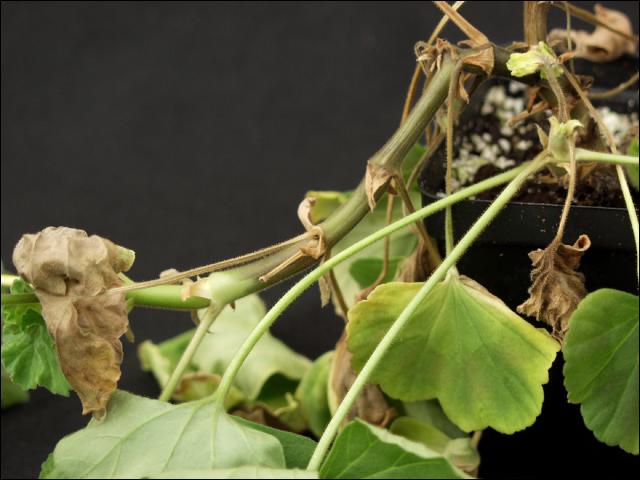
USDA working to destroy imported flowers linked to Ralstonia
Federal officials are working with greenhouses in 39 states to destroy infected pink geraniums and prevent an invasive bacterium from infecting vegetable crops, including potatoes.
USDA’s Animal and Plant Health Inspection Service (APHIS) recently confirmed a Ralstonia solanacearum race 3 biovar 2 (RSr3b2), a known threat to several vegetable crops, reached a Michigan greenhouse and its customers around the country. In an AmericanHort webinar on April 29, officials said a widespread quarantine and testing effort was underway.
RSr3b2 was identified in a Guatemalan shipment of Fantasia ‘Pink Flare’ geranium plants of geranium plants to a Michigan greenhouse, according to APHIS’ April 21 statement to industry stakeholders. The type of Ralstonia can cause disease “in several important agricultural crops such as potatoes, tomatoes, peppers and eggplant,” according to the statement.
The bacteria, which doesn’t naturally occur in the U.S., is very destructive, causing brown rot in potato, bacterial wilt in tomato or eggplant and southern wilt of geranium, according to a presentation made by APHIS’ Matt Royer in an AmericanHort webinar April 29.
The bacteria is strictly regulated as a quarantine pest at the federal level in the U.S., as well as Canada and the European Union. In the U.S., it’s one of seven “USDA plant protection and quarantine select agents and toxins,” a list created by the Agricultural Bioterrorism Protection Act of 2002. Pests on the list can be taken off or added every two years through a rulemaking process.
This is the first confirmed case of RSr3b2 in a U.S. greenhouse since 2004, and it also was detected in 2003. In each of those two previous years, APHIS oversaw the destruction of about 2 million plants to eradicate the bacteria, according to Royer said.
“You can kind of compare this to what we’re seeing today which we hope is much less impactful than it was back then,” he said. He said APHIS immediately took action to contain and eradicate the disease from the Michigan facility.
“The importer immediately stopped shipments of geranium plants to the United States upon confirmation of the detection and has voluntarily agreed to destroy all shipments that were pending export or en route to the United States,” according to APHiS’ written statement. “They also provided a list of 288 greenhouses in 39 states that received geranium cuttings from the Guatemala facility.”
The plants were also shipped to Canada, Royer said, and the USDA officials have been communicating with Canadian authorities.
In the U.S., Federal and State agriculture officials were visiting the 288 greenhouse locations to oversee the eradication efforts, he said. All Fantasia ‘Pink Flare’ geraniums were held for destruction, and other possible host plants at the greenhouses were being tested and would be destroyed if needed. Possibly-infected materials such as potting soils and containers were also being destroyed. And greenhouses are being sanitized before they are re-opened.
Michigan Department of Agriculture Plant Industry Section Manager Robin Rosenbaum said the RSr3b2 had been found due to a “very alert” greenhouse grower who noticed something was wrong with the plants and spoke up so tests could be conducted at the Michigan State University Plant & Pest diagnostics lab.
“Our belief and hope are it’s contained to this incident and shouldn’t impact or pertain to potato or vegetable crops,” Rosenbaum said in an interview with Vegetable Growers News. “We don’t believe the bacterium will have infected those crops. … It’s never been detected outside those infected greenhouses that had the infected geraniums,” she said.
She said the greenhouses were being very cooperative, and she’s hopeful to wrap up the majority of the response late this week (May 2) or early the following week.
University of Wisconsin-Madison Plant Pathologist Caitilyn Allen spoke in the AmericanHort webinar about a variety of ways to kill the bacteria and even control it. The bacteria can be killed by heat (122°F for 10 minutes), the removal of water (desiccation), and chlorine or hydrogen peroxide.
A drench of phosphoric acid product can be used to protect plant roots from natural infection from RSr3b2-contaminated water, although it doesn’t cure systematically-infected plants or protect plants from above-ground infections such as plant clipping utensils.
“This is pretty encouraging,” she said. “It suggests these bacteria are (killed by) a lot of different treatments, some of which are commercially accessible, and could be fitted to management,” she said.
She also presented research exploring why the RSr3b2 bacteria hasn’t taken root in the U.S. fields. In addition to facing competition from native bacteria, Ralstonia may be poorly equipped to deal with the freeze-thaw cycles of moderate winters, she said.
“This organism may be cool tolerant,” she said. “It is not tolerant of freezing and thawing.”
Above, Ralstonia solanacearum race 3 biovar 2 causes southern wilt of geranium. Photo: Dave Norman/University of Florida







